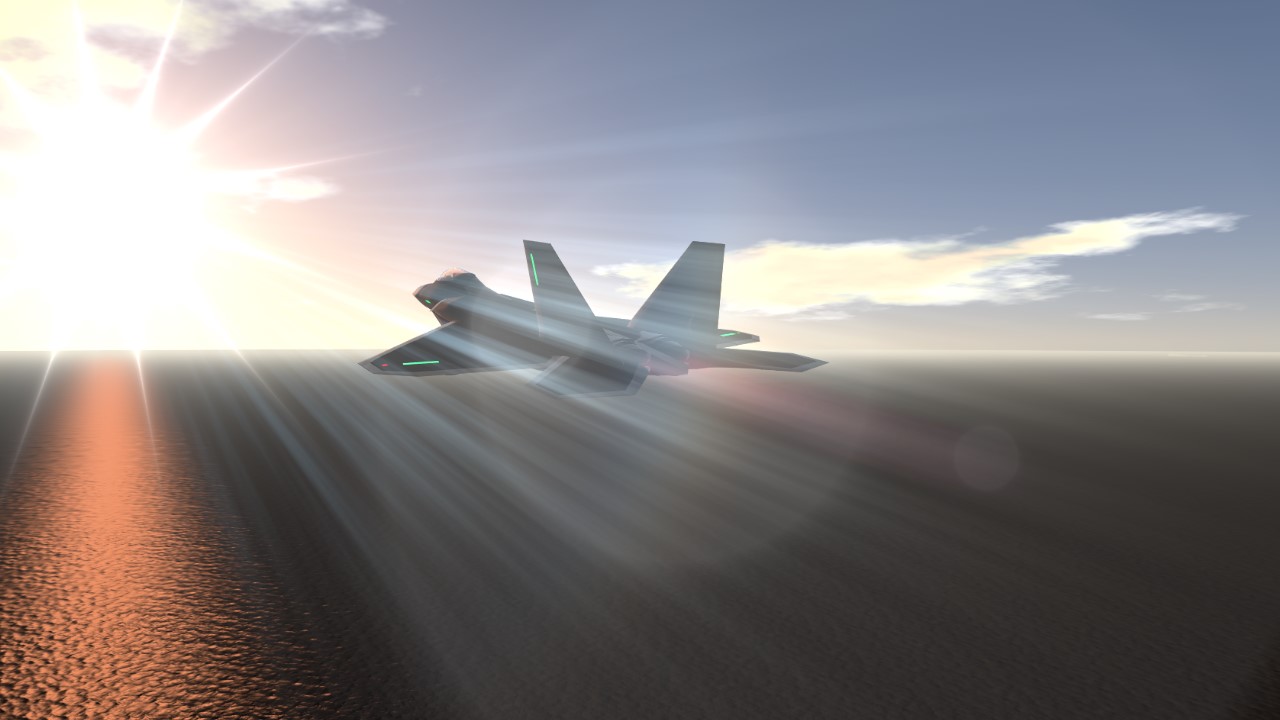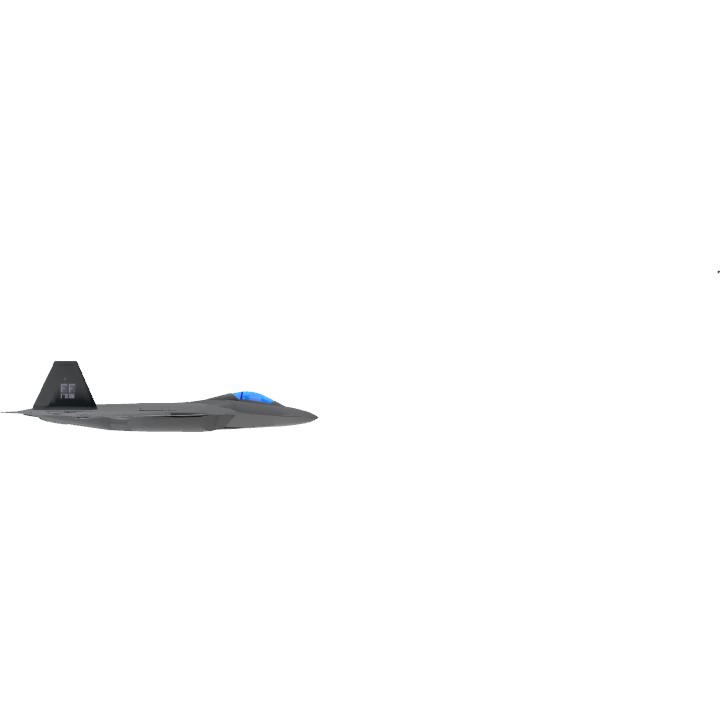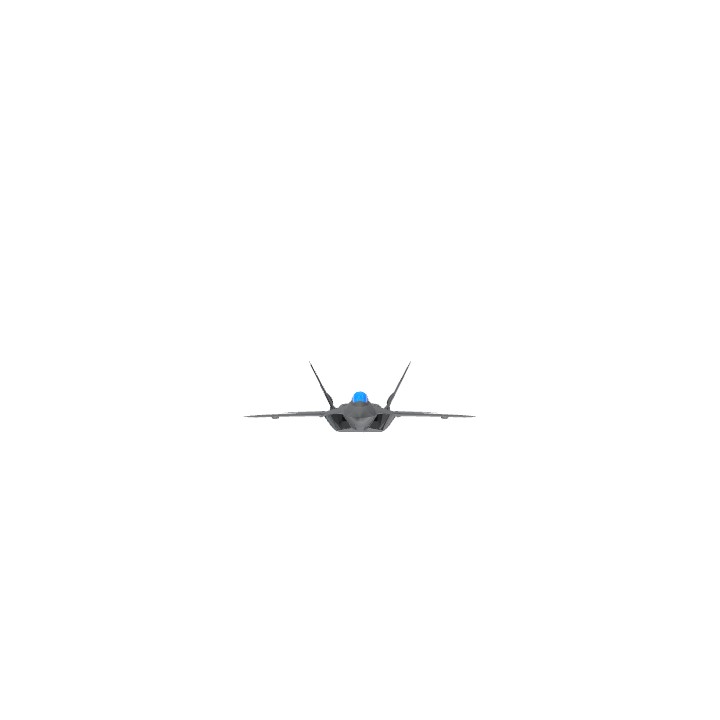Introducing the F22 Raptor. This is my final revision. Credit goes to GuyFolk for the foundation. I have heavily reworked the physics of the flight model to be able to achieve what the real Raptor can accomplish and what its airframe and thrust vectoring should theoretically be capable of.
I've worked hard to cut the parts down so it runs smooth on mobile and Quest 2. Feel free to peruse the variable setters and funky trees code to understand how I have coded the engines, control surfaces and thrust vectoring nozzles.
My Goal with this release was not accurate replication but rather a low part, ergonomic, VR friendly and functional cockpit with good forward visibility and an aircraft which does not compromise on capabilities or flight physics. Weapons also reflect this ethos as the traditional armament is x2 sidewinders and x6 AMRAAMs. AMRAAMs have been given multi role capabilities.
Notable achievements with this model include:
1) Fly by wire
Multiple iterations over the previous versions for general overall improvement in stability and maneouverability
- control surface deflection should multiply by the inverse of IAS squared for consistent forces
- thrust vectoring should by multiplied by the inverse of the output thrust
- absent or reversed control surfaces in certain conditions (extreme AoA, flying in reverse)
- differential thrust available for stability
- differential thrust for extreme yaw maneouvers (Activation Switch 4)
- AoA Limiter (Activation Switch 1)
- G limiter (can now be disabled by Activation Switch 2)
- Pitch Roll Stability (VTOL). default is 0 (Range -10 -> 10)
2) Landing Auto Throttle
This is enabled by default. Just keep the airbrake on approach and use the stick to adjust your glideslope. a PID controller will keep the Engines active to maintain a ~130knot approach. Flare before touch down to a Pitch Angle of ~12 degrees and plane will slowly kiss the runway.
3) Ground stability and manoeuvrability
Use Roll and/or Yaw controls whilst on the ground. Tire slip angles are calculated to feedback to steering system for smooth steering. at higher speed whilst on the ground, control surfaces automated to provide roll stability to resist wing strikes.
4) Variable setters for Pitch, Roll, Yaw, and Throttle
This allows adjusting exponential gains for Pitch/Roll axes. Yaw is given a smoothing function. Sensitivity slider (VTOL) controls the Pitch/Roll Stability and exponential function. (Note setting Stability to -10 allows aircraft to cobra to AoA ~90).
5) AirBrake Function
Airbrake can be used to bleed speed but also in conjunction with full aft stick, allows temporary disabling Pitch Stability Function allowing a cobra maneouver.
6) Throttle Thumbstick Disable
Throttle control from keyboard or thumbstick is disabled by default to allow for smooth independent rudder control in VR without inadvertent engine shutoff or afterburner activation. It also allows simultaneous Throttle and air brake application for tight min radius turns.
7) Radar/Nav System
This has been incorporated into the compass for locating targets and destinations. Destinations with runways also denote the orientation of the runway. you can cycle between desination waypoints by clicking on the compass in the cockpit.
8) HUD
This is purposely kept simple to be relevant in VR. A velocity vector and virtual horizons would need to be projected at a distance of infinity which is not possible (if anyone knows please chime in). So for readability and not obscuring targets, I've left the in game Gunsight/Target Lead and added only absolutely necessary items:
IAS (knots)
Alt AGL (ft) numerical + graphical elements to aid landing
Vertical Velocity (ft/s)
AoA (visual bars that turn amber and red when AoA>35 and AoA>90)
AoS (turn indicator at bottom of HUD)
controls input indicator
Update 1.06
see all changes up to 1.05
- MAJOR rework and simplification / code cleanup on FBW logic
- Much improved energy bleed simulation (Airbrake code optimised)
- All wings have been rotated forward so realistic AoA figures are shown at high speed (i.e. there will never be negative AoA in level flight. This also improves physics)
- Gravity correction factors for RollRate and YawRate can be enabled (Activate6) but this is not really useful for anything other than autopilot or very gentle banked turns aiming to keep zero sideslip
- Take off is now much smoother (more stable, less chance of tail strike) and landing controllability / stability is much improved
- Yaw inputs have had a major redesign - much smoother
- With default stability setting, AoA is restricted to ~30 for max Lift / turn performance (Note with full AB and high AoA, its still possible to achieve a tighter turn radius)
- AirBrake now modulates AoA Limiter, allowing full aft stick and full brake to perform a cobra maneouver
- Minor cockpit tweaks to buttons / text
The overall theme of this release is the application of correct formulas for FBW Simplification, Fluid Motion and Dynamic Stability to facilitate Maximum performance for the aircraft's characteristics (Weight, CG, Wing Loading, Thrust Vectoring, Differential Thrust). I have left a cockpit button if some may wish to enable gravity correction factors to YawRate and RollRate, however I find it less enjoyable and only worthwhile for slow coordinated turns. There was a necessary reduction in on centre Roll Tightness but this has resulted in more natural progressive control with more stability. This release is best enjoyed in PCVR but also works fantastic on native Quest 3. Please comment if there is anything I have overlooked. I am hoping this translates well to Simpleplanes 2 when its released.
Specifications
Spotlights
- This craft is curated
- KPLBall 1.5 years ago
General Characteristics
- Created On Windows
- Wingspan 45.1ft (13.7m)
- Length 139.6ft (42.6m)
- Height 34.8ft (10.6m)
- Empty Weight 42,325lbs (19,198kg)
- Loaded Weight 57,065lbs (25,884kg)
Performance
- Power/Weight Ratio 3.283
- Wing Loading 68.8lbs/ft2 (335.8kg/m2)
- Wing Area 829.8ft2 (77.1m2)
- Drag Points 2285
Parts
- Number of Parts 465
- Control Surfaces 4
- Performance Cost 1,892







@cosman oh ok. Thank you!
@Wolfgang8261YT G limiter took me a while to refine. Don’t use VerticalG. As you rotate the plane while pitching up it takes time to develop G’s but you can predict the G force by how fast the plane is rotating and the speed you are doing. The raw variable you should target is pitchrate. I created a variable called VertG which equates the expected G based on pitch rate and ground speed (simple circular motion mathematics). You can use debug expression to see VertG next to verticalG. Difference is the response time. So limiting based on VertG is really limiting using Pitchrate but more digestible as a G limiter. I find the pitch input required for say 10G then slowly multiply that pitch input by a GLim variable which is normally 1 up to say 8G then slowly ramps down to 0.6 or whatever when it reaches 10G sort of like artificially releasing the stick (something the pilot would do). I found that’s the smoothest way.
@cosman and thanks for the link!
@cosman interesting. I see what you mean. But honestly I'm kinda curious, how do you make fbw? As I've said before I'm not a genius when it comes to funky trees lol. But I'll be trying out what you've done with the cg on a few of the planes I have (not mine).
Yes I totally agree, 1.7 is a beauty! You are a talented creator. I'm not gonna lie, simpleplanes is kinda limited when it comes to realistic performance, but it's not impossible to have a build that flies how its supposed to. And it is weird when you have a plane that rockets to mach 2.5 in the space of 7 seconds and can pull a 35g 180degree turn in 2 seconds... I mean, come on bro
But anyway, I'm also intrigued at your G-limiter. How did you do it? Because every other glimiter that I've tried always makes the plane Bob madly when you start to reach 600kts. A bit like the stock wasp, which dosen't have a glimiter but still bobs for some reason. Anyway I'd love your thoughts on this!
@Wolfgang8261YT Have a look at this for some inspiration. Pretty much the original wasp but changed the MassScale of all front fuselage parts to zero to bring the CG backwards, changed the wings to Flat Bottom, changed the vertical stabilisers to NACAPROP, then funky trees for control surfaces to stabilise the aircraft. (similar code to the raptor). Because of no thrust vectoring, you NEED to use the main wing surfaces in conjunction with the tail to get stability. Plane is not perfect and can still spin particularly on Pitch down. I can however see that with the right logic, it can do whats expected.
https://www.simpleplanes.com/a/rVtKfH/Wasp-Tanker-CG12
@Wolfgang8261YT I really only made modifications to Guyfolks model. I think it’s totally reasonable to add long slim wings to the plane body to simulate body lift because fuselage parts have no lift. This raptor has that. Absolutely most important thing to do for a fighter is get the cg much more rearward than 99.99% of posted planes. It should be pretty much at the centre of lift. Then you can have the wings and tail providing lift for maximum turn performance. then you only really need subtle movements of your control surfaces, you’ll see that in this raptor (ps 1.07 flies even better than this 1.06). Fbw should create the stability to counter that effect. also aero effects increase with v^2, so you need to reduce the deflection as you gain speed, hence divide by pow(IAS,2). Make sure for example elevator is not only responding to pitch input but Pitch - Pitchrate/some constant and play with the numbers. Pitchrate is there to ensure if the plane keeps rotating because now you’ve made it balanced with the cg, it can then correct itself before it gets out of hand.
@cosman I get what you're saying. It is hard because you have to account for the bodies flat surface acting as a lifting surface especially when the wing swings. I had put some wings where the belly is (semi symmetrical I think) and I know it not supposed to but I tried. And I ended up with a annoying bobbing effect where if I pitched up vertically to hard, the aircraft would assume a heigh AOA then dip and Bob without really gaining any altitude. It could barely do a loop without stalling and even that would take like 4 minutes to do.
Anyway enough yapping. I don't know why it did that. The performance of the original plane itself as I have said was bad to begin with and I never really fully fixed it. But then there another Tomcat (I did some garbage remodeling of it it's on my profile) but the original plane flies pretty well. Excluding the fact that its way too light and stall at like 90 knots which is... ridiculous.
But if you go into it you'll se plenty of hidden wings around the plane. I dont know if those are like essentials to get a realistic performance, I'm not very good at aerodynamics but yeah. I try my stuff
Do you add small wings to your builds?
@Wolfgang8261YT The tomcat is indeed beautiful but ironically thrust vectoring makes it much easier to correct for aerodynamic deficiencies. From what I’ve learnt, I don’t think there are any aero interactions between surfaces but rather each airfoil functions independently and max lift is at ~28 AoA. Aero assessments of the f22 and su57 showed increasing lift all the way up to 40-45 AoA, yet they probably use symmetric airfoils for low drag. So I’ve canted all wings 1.4 deg forward and used flat bottom airfoils to closest approximate the desired lift vs AoA profile. Tomcat could reach 50 AoA if I remember correctly. But its controls are horizontal and vertical stabilisers and wing spoilers. Tails are also vertical rather than slanted so they won’t ever help pitch control. I just see so many limitations in simple planes physics modeling to be able to approximate a tomcat. You could make it fly smooth, but it would have to be severely aoa limited which is unrealistic and not so fun.
@cosman well I'd like to make a request if you dont mind. An F14. I've tried remodeling a few myself, but I've never really gotten a hang of aerodynamics like you lol.
I've worked on specifically deeznuts1234 (I think that's his name) own because it has a cockpit... and, well, I like. And I was going pretty well. I redid the cockpit made the handling a little smoother (because honestly it has some of the worst handling on the site to me). And I was going to ask for permission to upload it and I got sabotaged and my sp game uninstalled so I lost everything.
Kinda lost my vibe to start over.
But enough of me ranting. I'd appreciate it if you could do an F14A. Thank you!
@Wolfgang8261YT thanks again. Yea for sure I’m open to ideas. Can’t make any promises though, based on my limited creativity, time and other commitments.
@cosman you are a real creator, I wish I could give you 100 upvotes. Keep creating. I look forward eagerly to more content from you.
Ps. A question. Do you take requests?
@Wolfgang8261YT Thank you my friend for the immensely kind words. It really encourages me to keep pushing the envelope. My hope is to inspire and share my learnings with others and grow the community.
My man, its really hard to find models that look good, fly well, and yet are detailed. But you managed to combine all these and yet still it has a low performance cost. This deserves to be featured. My man, I cannot say what a masterpiece this is. Good job
This is really cool, I've followed all of these since the first version, these planes have improved greatly
Get spotlighted